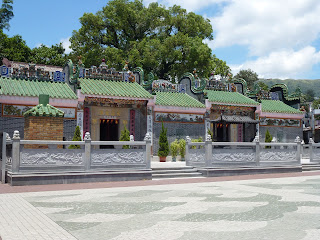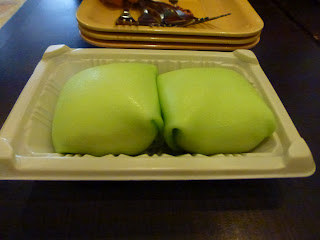Sorry this is a day late, I uploaded the photos but was too tired/lazy to write anything.
We were meeting up with some relatives in Ma On Shan (馬鞍山), so we took a bus to Sha Tin and hopped on the train:
One stop to Tai Wai (大圍, lit. "big walled [village]", referencing the old traditional village in the area, one of Hong Kong's largest)We were meeting up with some relatives in Ma On Shan (馬鞍山), so we took a bus to Sha Tin and hopped on the train:
Where we got on the Ma On Shan line.
Sha Tin, being a New Town, is full of public housing estates, like this one.
All public housing estates have a distinctive red logo somewhere on them. That is the logo of the Hong Kong Housing Authority (香港房屋委員會), the government department in charge of public housing in the city.
We pass the Hong Kong Heritage Museum (香港文化博物館):
As we approach the town of Ma On Shan, we can see a distinctive shape in the distance (on the left):
Ma On Shan literally translates to "horse saddle mountain", the distinctive saddle-shaped landform in the distance there.Like all of Hong Kong, Ma On Shan has one side facing mountains, and the other side facing the sea. In this case, it faces Tolo Harbour (吐露港), where the Shing Mun river meets the South China Sea.
We get off at the end of the line:
And after meeting up with the aforementioned relatives, head to the bus terminus underneath, to catch this bus:
Sai Kung (西貢) is a popular day trip for locals and tourists, for a quick getaway from the hustle and bustle of the big city. It's a (relatively) small town on the rugged east coast of the New Territories, and is accessible by a 30 minute bus ride from Ma On Shan or western Kowloon.A few observations on the trip there:
The Kowloon Motor Bus Company (九龍巴士有限公司) or KMB (九巴), the largest bus operator in the city, and one of the largest privately-owned public transit bus companies in the world, runs this route.
Its logo is a stylized Chinese "nine" (九) from "Kowloon".
Here you can see new luxury condos being built in Ma On Shan, as it does have a bit of unused land:
Hundreds of vertical metres of bamboo scaffolding. Only in Hong Kong.
At the end of the freeway:
Ma On Shan from the side. You can't see the saddle...
and at the foot, a small village:
From this angle, the saddle is a lot clearer.
Just some of the scenery heading in: mountains and sea.
 |
| With a bonus finger pointing at... open ocean? |
As we approach, the building density increases:
When we get off the bus, we head over to the visitors' centre,
before heading out to the pier.
Many traditional sampans (舢舨) dot the Sai Kung Harbour.
Being on the coast, Sai Kung is one of the better places to enjoy seafood in Hong Kong, and many local seafood restaurants have popped up along the waterfront.
I don't know if you can tell (sorry about the reflection, the sun was directly behind me!), but these fish are enormous:
A huge selection of live seafood:
such as these "pissing" mantis shrimp (攋尿蝦), named for their tendency to shoot water out when picked up.More typhoon damage! This tree was uprooted, along with its brick base:
A walk around town:
 |
| Salted fish drying in the sun! |
This name is quite ironic:
As this is the street:
Stripped of its linoleum covering, this old building's walls show their true structure: random rocks thrown together with some mortar, harking from a time without the plenty of today.
Yet another temple dedicated to the Goddess Tin Hau can be found here, as well as almost everywhere in the city, as Tin Hau is the traditional goddess of seafarers:
Lunch was at another soy sauce Western place, which is apparently quite well-known locally:
All standard soy sauce Western meals come with a soup, main, and drink.
There were two soup choices. One, called "Russian" Borsch (羅宋湯):
is an almost completely local invention, devoid of the beets and sour cream found in actual borsch, and more reminiscent of a Chinese take on vegetable soup, sharing the same tomato base and filled with veggies.
I grew up with this stuff in cha chaan teng around Toronto!
The other is a cream of corn, mushroom, and chicken soup:
For the mains, you choose a meat, a gravy, and a starchy side. I had beef tenderloin in onion gravy with fried rice:
My mom had sirloin in black pepper sauce with fries:
and my brother had chicken in black pepper sauce with spaghetti.
(Everyone else had tenderloin in black pepper sauce with fries!)
For all their meats, they use meat tenderizer, giving it a completely different consistency from Western steakhouses. But the locals love it.
For dessert, we went to Honeymoon Dessert (滿記甜品):
They are well known for being the first to introduce desserts made from durian, the "king of fruits" with a very specific odour that is off-putting to many. Durian, being native to Southeast Asia, is used extensively in that cuisine, and can get so stinky that the rapid transit system in Singapore, the MRT (as opposed to the MTR here!) has forbidden passengers from carrying the fruit.A durian "pancake", durian meat and cream wrapped in a durian-flavoured crêpe.
There was also a sago, grass jelly and ice cream dish,
And a mango and grass jelly dish.
Drinks! A coco de mer (海底椰) concoction:
Apparently, the coco de mer got its name as the first specimens were found drifting onto the shores of the Maldives, seemingly from nowhere. When the Seychelles were inhabited later, their origin was found.
Mango slush with some ice cream on top:
And lychee slush - with Perrier. Fancy.
We headed back the other way, through Kowloon:
 |
| Leaving the town of Sai Kung. |
 |
| The Chinese actually reads "have your lane chosen." |
 |
| This year marks the 15th anniversary of Hong Kong's return to China... but more of that in the poltics post! |
 |
| Finally back into civilization. |
 |
| Kowloon, with Hong Kong Island in the distance. |
 |
| That symbol look familiar? (Oh, and that tree was upright before!) |
 |
| Lion's Rock in the distance. Look more like a lion from this angle? |


































































No comments:
Post a Comment